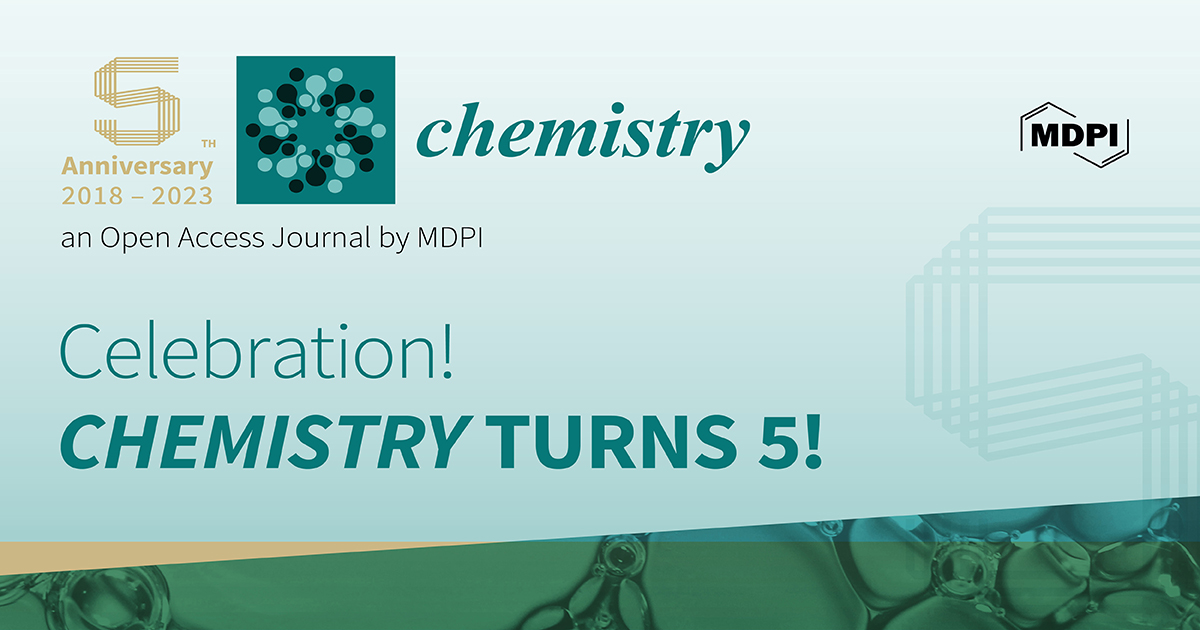Five Years of Chemistry — Chemistry and the SDGs
A special issue of Chemistry (ISSN 2624-8549).
Deadline for manuscript submissions: closed (15 November 2023) | Viewed by 1623

Special Issue Editors
Interests: heterogeneous catalysis; CO2; biomass
Special Issues, Collections and Topics in MDPI journals
Interests: new syntheses of high value added molecules through catalytic assembly of simple units; innovative syntheses of heterocyclic molecules of pharmaceutical; agrochemical; applicative interest; carbonylation chemistry; use of non-conventional solvents in organic synthesis; synthesis and semi-synthesis of bioactive compounds of pharmaceutical or agrochemical interest; synthesis of new materials for advanced applications; extraction; characterization; evaluation of the biological activity of bioactive principles from natural matrices
Special Issues, Collections and Topics in MDPI journals
Interests: light harvesting using inorganic coordination complexes as dyes in dye-sensitized solar cells (DSCs); development of emissive complexes for application in light-emitting electrochemical cells (LECs); water splitting and water oxidation catalysts;functional coordination polymers and networks
Special Issues, Collections and Topics in MDPI journals
Special Issue Information
Dear Colleagues,
In 2015, the United Nations member states adopted The 2030 Agenda for Sustainable Development. This document provides a blueprint and actions for ensuring a healthy, peaceful and prosperous planet. The core actions are 17 Sustainable Development Goals (SDGs), which are imperative for all nations to act together in a global partnership to address the most urgent challenges to our planet's and species' sustainability. These bold goals attempt to solve all issues through mutually synergistic strategies to end poverty and inequality whilst improving health and education, tackling climate change, preserving our environment, and spurring economic growth. To fulfil these goals, we must build strategies focusing on improving health and education, ensuring economic growth and gender equality. These strategies must go together with actions in water, energy, climate, oceans, urbanization, transport, science, and technology.
Chemistry plays a pivotal role in developing technologies to achieve sustainable fuels and energy vectors, achieve food security and sustainable agriculture, and chemicals for health care or clean water. Process intensification must help reduce plant size and by-products and favour reducing countries' and regions' inequalities. Waste reduction by recycling and more efficient green chemical processes will ensure sustainable consumption and production patterns. Catalysis is central to most chemical technologies; biomass-to-fuels or CO2-to-commodities are examples of catalytic-driven processes. New therapies rely not only on small molecule chemistry, but also on solid state chemistry, biochemistry or polymer chemistry: magnetic nanoparticles offer new potential for cell destruction, biochemical therapy can overcome neurotransmission problems, and smart nanopolymers that change their conformation to deliver drugs to specific targets are among chemistry-based technologies helping to fulfil the SDGs.
This Special Issue aims to emphasize the role of chemistry and, in particular, catalysis in helping to achieve the SDGs and tackle climate change.
All submitted papers will undergo rigorous peer review by international experts in the field. The collection of accepted manuscripts will be published as a Special Issue in Chemistry, the 5th Anniversary series.
Prof. Dr. José Antonio Odriozola
Prof. Dr. Bartolo Gabriele
Prof. Dr. Edwin Charles Constable
Guest Editors
Manuscript Submission Information
Manuscripts should be submitted online at www.mdpi.com by registering and logging in to this website. Once you are registered, click here to go to the submission form. Manuscripts can be submitted until the deadline. All submissions that pass pre-check are peer-reviewed. Accepted papers will be published continuously in the journal (as soon as accepted) and will be listed together on the special issue website. Research articles, review articles as well as short communications are invited. For planned papers, a title and short abstract (about 100 words) can be sent to the Editorial Office for announcement on this website.
Submitted manuscripts should not have been published previously, nor be under consideration for publication elsewhere (except conference proceedings papers). All manuscripts are thoroughly refereed through a single-blind peer-review process. A guide for authors and other relevant information for submission of manuscripts is available on the Instructions for Authors page. Chemistry is an international peer-reviewed open access semimonthly journal published by MDPI.
Please visit the Instructions for Authors page before submitting a manuscript. The Article Processing Charge (APC) for publication in this open access journal is 1800 CHF (Swiss Francs). Submitted papers should be well formatted and use good English. Authors may use MDPI's English editing service prior to publication or during author revisions.
Keywords
- sustainable development goals
- catalysis
- energy
- diagnosis and therapy
- nanoscale science
- open Science
- materials chemistry







